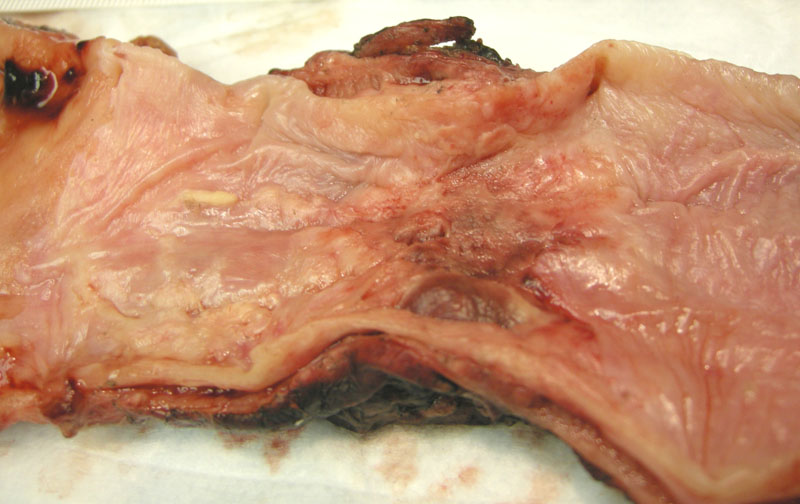

This tumor created an impressive ulcerated lesion in the lower esophagus. The z line is to the left. Overall, squamous cell carcinomas occur in the middle third of the esophagus 50% to 60% of the time, the distal third in 30%, and the proximal third in 10% to 20%.
The surface epithelium demonstrates carcinoma in situ with underlying inflammation. A two-tiered system (low-grade and high-grade) is preferred for classifying dysplasia-- low-grade dysplasia includes “mild” and “moderate,” and high-grade dysplasia includes “severe” and “carcinoma in situ”
Tumors tend to invade vertically, with extensive myoinvasion by malignant squamous cells. Superficial squamous cell carcinomas are those that invade the mucosa and submucosa but do not penetrate the muscularis propria. This example would therefore represent an advanced case.
A different case illustrrates squamous cell carcinoma involving a nerve.
This ulcerating squamous cell carcinoma shows replacement of the submucosa with tumor.
Keratin pearls are found in some areas.
Squamous cell carcinoma (SCC) is the most common type of esophageal cancer worldwide but not in the US. It affects men more often than women, has a peak incidence in the seventh decade and a marked geographic and ethnic variation in incidence. Highest rates occur in China, Iran, South America, and South Africa and here in the United States, it is more common in black versus white men. Achalasia, Plummer-Vinson syndrome (iron deficiency, glossitis and dysphagia), celiac disease and nutritional factors such as high nitrosamine levels represent potential risk factors.
Important risk factors include alcohol and tobacco smoke here in the US and other Western countires, found in up to 90% of carcinomas. The risk of esophageal SCC is actual dose related to alcohol intake.
Typical symptoms include weight loss and dysphagia. A small minority develop hypercalcemia due to tumor elaboration of a parathyroid hormone-related protein. Up to 1/3 have another head and neck tumor.
Frequently, esophageal SCC is diagnosed when patients are already symptomatic, and by this time, the disease has progressed to regional lymph nodes and beyond, and thus management is generally only palliative. Conventional treatment for cure of early esophageal cancer is
surgery either with or without radio- or chemotherapy.
Overall 5-year survival approaches 30 to 40% for patients treated with esophagectomy. The most significant prognostic factor is tumor stage. Tumors into the submucosa are associated with 5-year survival rates of roughly 70%, compared with 40% to 50% and 25% to 30% if the tumor is limited to the the muscularis propria and adventitia, respectively (Glickman). Positive lymph nodes is also an independent predictor of poor survival.
Glickman JN. Section II: pathology and pathologic staging of esophageal cancer. Semin Thorac Cardiovasc Surg. 2003 Apr;15(2):167-79.